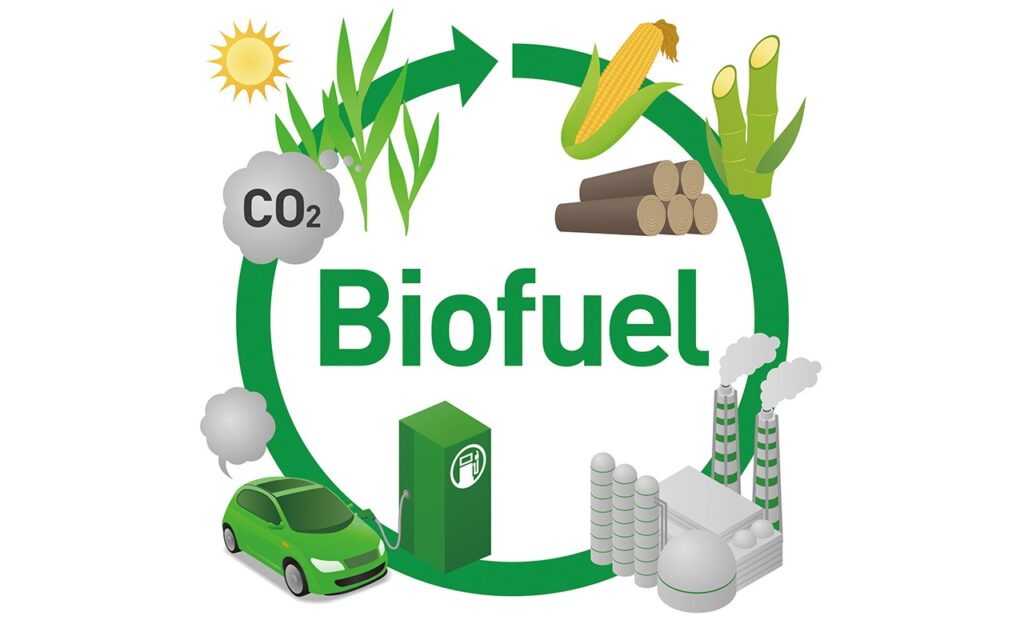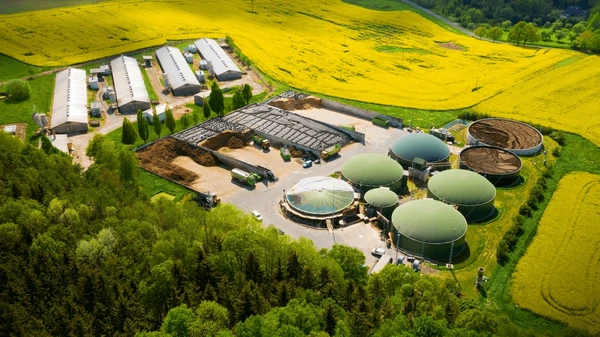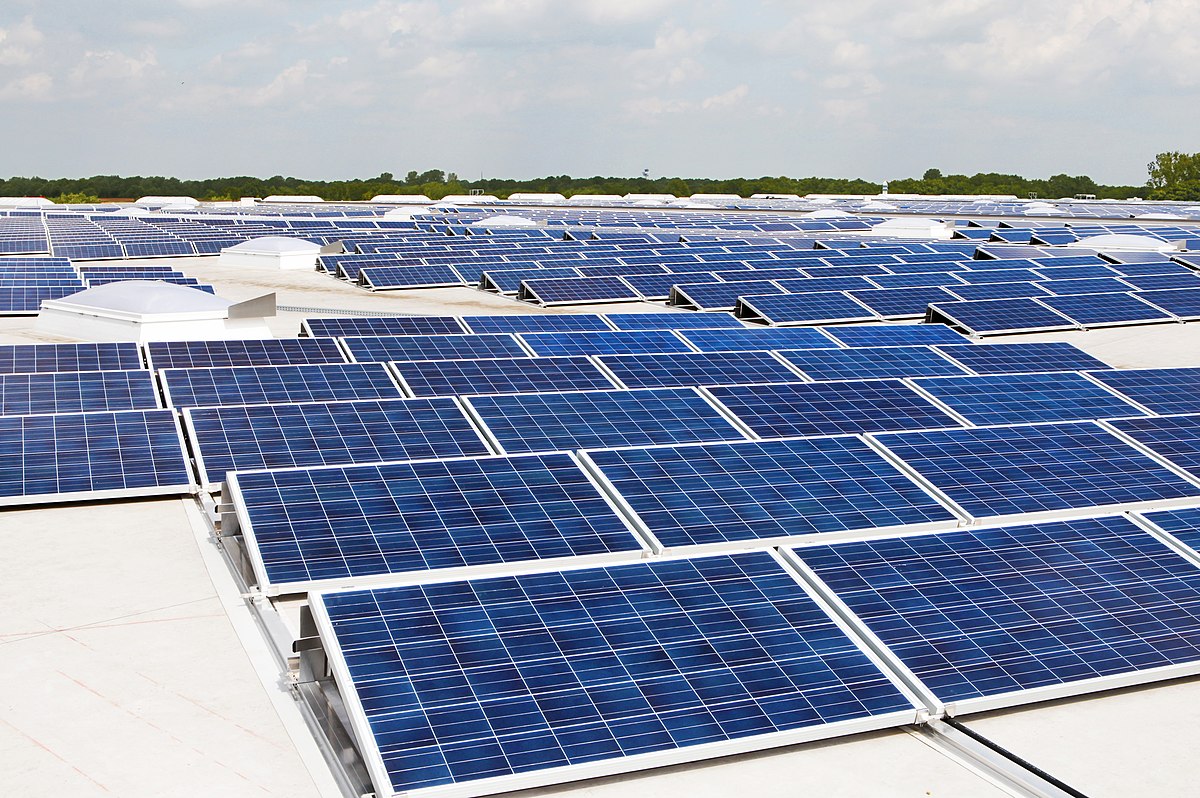Biomass and Biofuels: A Renewable Energy Source and 11 Strategies to Invest in the Sector
Introduction:
As the world grapples with the escalating challenges of climate change and the need for sustainable energy alternatives, biomass and biofuels have emerged as promising solutions.

Derived from organic materials such as plants, agricultural residues, and even waste products, biomass and biofuels offer a renewable energy source that can play a pivotal role in transitioning towards a cleaner and more sustainable energy landscape.
Biomass as a Resource:
Biomass refers to any organic material derived from plants or animals, and it serves as a versatile resource for energy production. This can include wood, crop residues, dedicated energy crops, and organic waste. The key advantage of biomass lies in its ability to store solar energy through photosynthesis, converting it into chemical energy that can be harnessed for various applications.
Types of Biomass Energy:
- Biopower: Biomass can be burned directly for heat and electricity generation. This process involves the combustion of organic materials to produce steam, which then turns turbines connected to generators. Biopower is particularly valuable for decentralized energy production and can be utilized in both residential and industrial settings.
- Biofuels: Biomass can also be converted into biofuels, such as bioethanol and biodiesel. Bioethanol is produced through the fermentation of sugars found in crops like corn and sugarcane, while biodiesel is derived from vegetable oils and animal fats. These biofuels can serve as direct substitutes for traditional fossil fuels, reducing greenhouse gas emissions and diminishing dependence on finite resources.
Advantages of Biomass and Biofuels:
- Renewable Nature: Unlike fossil fuels, biomass is a renewable resource as long as it is managed sustainably. As plants grow, they absorb carbon dioxide from the atmosphere, creating a closed carbon cycle when burned for energy.
- Carbon Neutrality: While the combustion of biomass releases carbon dioxide, it is considered carbon-neutral because the plants consumed during growth absorbed a comparable amount of carbon dioxide. This helps mitigate the overall impact on atmospheric carbon levels.
- Waste Utilization: Biomass energy often involves the use of agricultural residues, forestry by-products, and organic waste, contributing to waste reduction and providing an additional economic incentive for waste management.
Challenges and Future Outlook:
Despite its promising potential, biomass and biofuels face challenges such as land use competition, resource availability, and the need for advanced technologies to improve efficiency and reduce costs.
Additionally, the sustainability of biomass production practices must be carefully managed to prevent negative environmental impacts.
Looking ahead, ongoing research and development are crucial for enhancing the efficiency of biomass conversion processes and expanding the range of feedstocks.
Integrating biomass into a diversified and sustainable energy portfolio can contribute significantly to meeting global energy demands while mitigating the environmental consequences associated with traditional fossil fuels.
Biomass and biofuels represent a renewable energy source that harnesses the power of organic materials to address the growing energy challenges of the 21st century.
With continuous advancements in technology and sustainable practices, these resources can play a vital role in fostering a greener, more resilient energy future, reducing our reliance on fossil fuels and mitigating the impacts of climate change.
As we celebrate the potential of biomass on its journey from organic matter to sustainable energy.

The ongoing commitment to innovation and responsible management will be key to realizing its full benefits.
The Discovery of Biomass and Biofuel
The discovery and utilization of biomass and biofuels have deep historical roots, spanning centuries of human innovation.
While the concept of using organic materials for energy may seem like a contemporary development, its origins can be traced back to ancient civilizations.
The journey of discovering and harnessing the power of biomass and biofuels reflects the intersection of human ingenuity and the ongoing quest for sustainable energy sources.
Ancient Practices: The earliest instances of biomass utilization for energy can be found in the practices of ancient civilizations.
Early humans discovered that burning wood, a form of biomass, provided heat and light.
Wood, being abundant and renewable, became a primary source of energy for cooking and warmth.
This marked the initial recognition of the energy potential inherent in organic matter.

The Agricultural Revolution: The transition to agriculture marked a significant turning point in the discovery of biomass as an energy resource.
As societies cultivated crops, residues such as straw and crop waste were recognized for their combustible properties.
Agricultural communities began using these residues for cooking and heating, unintentionally laying the groundwork for future bioenergy applications.
Industrial Revolution and Biofuels: The Industrial Revolution brought about a shift in energy needs, and biomass continued to play a crucial role.
The advent of steam engines powered by burning wood or coal marked a major stride in biomass utilization.
During this era, animal fats were also employed as a source of energy, serving as early biofuels.

Bioethanol in the 20th Century: In the 20th century, advancements in chemistry and technology led to the development of bioethanol as a liquid fuel.
Researchers discovered that fermentation could convert sugars from crops like corn and sugarcane into ethanol.
This marked a pivotal moment in the recognition of biofuels as alternatives to traditional fossil fuels.
Modern Advances: The late 20th and early 21st centuries witnessed a surge in interest and research focused on biomass and biofuels.
Growing concerns about climate change and the finite nature of fossil fuels prompted increased exploration of renewable alternatives.
Researchers delved into refining processes for bioethanol and biodiesel, optimizing production from various feedstocks.

Challenges and Opportunities: The discovery of biomass and biofuels has not been without challenges.
Issues such as competition for land, resource sustainability, and economic viability have required ongoing attention.
However, the growing understanding of these challenges has fueled further innovation, leading to the exploration of advanced biofuel technologies.
Including second and third-generation biofuels derived from non-food crops and waste materials.
The Future of Biomass and Biofuels: As we celebrate the introduction of biomass and biofuels, it is crucial to recognize the dynamic nature of this field. Ongoing research and technological advancements hold the key to unlocking the full potential of these renewable energy sources.
The journey from ancient practices to modern bioenergy solutions exemplifies humanity’s resilience and adaptability in addressing energy needs while striving for a sustainable and environmentally conscious future.
The viable investment opportunities in Biomass and Biofuel
Investing in biomass and biofuel presents compelling opportunities in the rapidly evolving landscape of renewable energy.
As global awareness of climate change grows and the demand for sustainable energy solutions intensifies, investors are increasingly turning their attention to biomass and biofuel projects.
Here are several viable investment opportunities in this sector:
- Bioenergy Production Facilities: Investing in bioenergy production facilities is a direct way to participate in the biomass and biofuel industry. These facilities can include biopower plants that generate electricity through the combustion of biomass or biofuel production plants specializing in ethanol, biodiesel, or other bio-based fuels. Such investments offer revenue streams from the sale of energy or biofuels.
- Advanced Biofuel Technologies: Focusing on companies or projects involved in the development of advanced biofuel technologies is a forward-looking investment strategy. Second and third-generation biofuels, derived from non-food feedstocks like algae, agricultural residues, or waste materials, are gaining traction for their potential to address sustainability concerns and improve efficiency.
- Feedstock Production and Supply Chains: Investing in the production and supply chains of biomass feedstocks presents opportunities in supporting the raw materials needed for bioenergy and biofuel production. This may involve investing in dedicated energy crops, forestry operations, or companies specializing in collecting and processing agricultural residues and organic waste.
- Biorefineries: Biorefineries are versatile facilities that convert biomass into a range of valuable products, including biofuels, chemicals, and materials. Investing in biorefinery projects allows participation in a diversified set of markets, offering resilience against fluctuations in any specific product category.
- Waste-to-Energy Projects: Waste-to-energy projects involve converting organic waste into energy through processes such as anaerobic digestion or thermal conversion. Investors can explore opportunities in waste management companies that integrate biomass utilization for both waste reduction and energy generation.
- Research and Development in Bioenergy: Investing in companies or initiatives focused on research and development in bioenergy technologies can yield long-term benefits. Innovations in efficient biomass conversion processes, genetic engineering of energy crops, and advancements in biofuel production methods have the potential to shape the future of the industry.
- Carbon Credits and Renewable Energy Certificates (RECs): Investors can explore opportunities in the carbon credit and REC markets. Biomass and biofuel projects that reduce greenhouse gas emissions may qualify for carbon credits, providing an additional revenue stream. Similarly, RECs can be generated from the production of renewable energy, offering a tradable commodity that supports clean energy initiatives.
- Government Incentive Programs: Many governments offer incentives, subsidies, and tax credits to encourage investments in renewable energy, including biomass and biofuel projects. Keeping abreast of these programs and aligning investments with supportive policies can enhance the overall financial viability of projects.
- International Partnerships: Given the global nature of the biomass and biofuel industry, international partnerships and collaborations can present attractive investment opportunities. This may involve supporting projects in regions with abundant biomass resources or partnering with companies that have expertise in specific markets.
- Energy Storage and Integration: Investing in technologies that enhance the integration of biomass and bioenergy into existing energy systems, including energy storage solutions, grid management, and smart energy technologies, can contribute to the overall efficiency and reliability of renewable energy sources.

Before making any investment decisions, thorough due diligence is essential. Factors such as feedstock availability, regulatory environments, technological maturity.
And market demand should be carefully assessed to ensure the sustainability and profitability of investments in biomass and biofuel projects.
Additionally, staying informed about emerging trends and developments in the renewable energy sector is crucial for making well-informed investment choices.
11 Guides on how Investors can Initiate Contacts with Relevant Organisation
Contacting organizations to explore investment opportunities in biomass and biofuel requires a strategic and professional approach.
Here’s a guide on how investors can initiate contact with relevant organizations:
- Research and Identify Targets:
- Conduct thorough research to identify organizations involved in biomass and biofuel projects. This may include bioenergy production companies, research institutions, renewable energy startups, or firms specializing in advanced biofuel technologies.
- Look for information on their projects, financial stability, and overall reputation within the industry.
- Utilize Online Platforms:
- Explore online platforms dedicated to connecting investors with renewable energy projects. Websites, forums, or investment portals focused on the clean energy sector can provide valuable insights and contact information.
- Attend Industry Events and Conferences:
- Attend conferences, seminars, and industry events related to biomass, biofuels, and renewable energy. These gatherings offer networking opportunities where investors can meet key players in the field.
- Engage in discussions, participate in workshops, and take advantage of networking sessions to establish connections.
- Reach Out Through Professional Networks:
- Leverage professional networks, both online and offline, to identify potential investment opportunities. Platforms like LinkedIn can be valuable for connecting with professionals in the renewable energy sector.
- Join relevant groups and participate in discussions to expand your network and gain insights into potential investment prospects.
- Contact Industry Associations:
- Reach out to industry associations and organizations dedicated to promoting biomass and biofuel initiatives. These groups often have information about ongoing projects and can facilitate introductions to key stakeholders.
- Engage with Government Agencies:
- Explore government agencies responsible for renewable energy policies and initiatives. These agencies can provide information on projects, funding opportunities, and potential investment avenues.
- Attend government-sponsored events or forums focused on clean energy to connect with project developers and industry experts.
- Utilize Investment Advisory Services:
- Seek assistance from investment advisory services specializing in renewable energy. These professionals can provide insights, identify suitable investment opportunities, and facilitate introductions to key players in the industry.
- Direct Outreach:
- Once potential organizations have been identified, initiate direct outreach through professional channels. This may include sending introductory emails, making phone calls, or scheduling meetings.
- Clearly articulate your interest in biomass and biofuel investments, highlighting your investment criteria, objectives, and the value you bring as an investor.
- Participate in Webinars and Web Conferences:
- Attend webinars and virtual conferences focused on biomass and biofuels. These events offer opportunities to learn about the latest industry trends and connect with relevant organizations.
- Engage with speakers, panelists, and participants during Q&A sessions or through virtual networking platforms.
- Collaborate with Investment Platforms:
- Explore investment platforms and crowdfunding websites that specialize in renewable energy projects. These platforms often curate a selection of projects, making it easier for investors to find suitable opportunities.
- Build Relationships Gradually:
- Approach organizations with a long-term perspective. Building relationships gradually allows for a better understanding of the organization’s goals, project timelines, and potential alignment with your investment strategy.
When contacting organizations, it’s essential to be clear, concise, and professional in your communications.
Clearly state your investment interests, inquire about available opportunities, and express your willingness to discuss potential collaborations.
Building a strong network within the biomass and biofuel industry is an ongoing process that requires persistence, active engagement, and a genuine interest in contributing to the growth of sustainable energy solutions.
CONCLUSION
In conclusion, Biomass and Biofuels stand as formidable pillars in the edifice of renewable energy, offering a sustainable and transformative solution to the world’s escalating energy demands.
It is evident that the journey from ancient practices to cutting-edge technologies has positioned biomass and biofuels as key players in the global energy landscape.
The 11 investment strategies outlined here provide a comprehensive roadmap for investors seeking to contribute to and benefit from the growth of this dynamic sector.
From bioenergy production facilities to advanced biofuel technologies, each avenue represents a unique opportunity to participate in the evolution of clean energy.
In embracing these strategies, investors not only align themselves with the imperatives of environmental stewardship but also position themselves at the forefront of an industry poised for exponential growth.
As governments worldwide intensify their commitment to decarbonization and sustainable development.
The demand for biomass and biofuels is set to soar, creating an opportune moment for strategic investments.
This journey into the heart of renewable energy is not just about financial gains; it is a collective endeavor to reshape the energy landscape for the benefit of future generations.
As investors embark on this venture, they become catalysts for innovation, advocates for sustainable practices.
And contributors to a future where clean, renewable energy is not just an option but an imperative.
In the symphony of progress, biomass and biofuels play a resounding melody, echoing the harmony of nature and human ingenuity. The path forward is paved with possibilities.
And the investment strategies outlined here serve as the compass guiding investors towards a future where biomass and biofuels illuminate the way to a sustainable and resilient world.
As we commemorate the journey of these renewable energy sources, let us embrace the responsibility and privilege of shaping an energy future that transcends boundaries, enriches lives, and preserves the planet for generations to come.





Leave a Reply